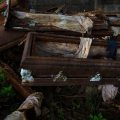This story first appeared in Curios and Conundrums: Gods of Madness (April 2017) from The Mysterious Package Company. The theme of the issue was madness in Victorian England.
I tapped my wrist, and the familiar green digits glowed through my skin. 23 hours remaining.
Safe as I was for the moment, the park was alarmingly well trafficked that day. The threat of being discovered was counterbalanced by the wide variety of costuming available to me. After an anxious wait, I dealt a thumping blow to an oblivious but dapper gentleman in a smart patterned vest and a dark cravat. I left him his stifling coat, and covered his face with his top hat, which he could use to cover the ensuing lump on his head once he came to.
Suitably attired, I emerged from the copse to get my bearings. The park was clustered with men and women chattering excitedly. I drew near to them as I walked, hoping to catch the gist of their conversation. Here were men discussing the operation of a steam hammer, while others were raving about an enormous sphinx, and still others were arguing about, of all things, dinosaurs.
But as I walked, the one word that toppled enthusiastically from every set of lips was “diamond.”
“Diamond!” My pulse quickened. “Diamond!” The crowd thickened. “Diamond!” What the Dickens?
I didn’t have far to walk before I was enveloped by a giddy crowd of Londoners whose rambunctiousness betrayed the formality of their stodgy dress. As I rounded the corner, the locus of their loquaciousness came into view: a massive glass building stretching a mile across the mall, and buzzing like a hive filled with stiff-collared and tightly corsetted bees. I had blundered into the Great Exhibition of 1851.
Ordinarily, I aim to return to the crater on time with the most valuable object I can acquire. When things go swimmingly, this is hopefully an item of some renown. If things head south, I can always punch a passerby in the face and abscond with his pocket change. But this approach typically doesn’t go over well with Boss Teegan. The value of my spoils must exceed the cost of travel, or the auction house loses money. And my life is more difficult when the auction house loses money. Consequently, the thought of nicking a diamond from the fair was tantalizing, to say the least.
I skipped the lengthy queue and slipped past the red-coated sappers stationed at the entrance — Alexander Musick doesn’t wait in line —, and found myself inside the glittering dome of the Crystal Palace. The entire population of London, and more besides, appeared to have crammed itself into the building. In addition to a large pink glass fountain, several huge statues, and an entire taxidermied elephant, the multi-level edifice housed a cluster of tremendous trees, around which the entire glass structure had been built.
Tapping my wrist habitually, I spent the next few hours of my dwindling time absorbed in the distracting sights and cacophonous sounds of the fair. Finding the steam hammer was an easy feat, as the metal monstrosity rose to over twice the height of a man, looking every bit like an invading Martian mechanoid. The hammer, I learned, could deliver a blow of more than 100 tons, acting as an overpowered nutcracker to shatter anything placed in its path. I breezed passed an overwhelming collection of clocks and their creators, whose intricate inventions told not only the time, but the days of the week and the phases of the moon. The relentless ticking and clucking made me a little too conscious of my own time limit, and I hurried myself to another area of the hall.
An Australian doctor named Gray proudly displayed a medical walking stick that would put the Swiss Army to shame, containing forceps, a pillbox, a syringe, a catheter, and even an enema. A man named Sadd exhibited a model of his pedal-propelled flying machine, and I considered how apt his name would become if he ever got the chance to try it out. Of particular interest to someone of my proclivities was a locksmith named Hobbs, who announced that he had sailed from America to reveal the shocking truth behind something called the Chubb Detector. The man drew a sizable crowd of people murmuring that their own belongings were secured by the Detector, an apparently tamper-proof lock. They were shocked and dismayed by Hobbs’s subsequent performance. Elsewhere, a surgeon named Dimsdale delivered a brief oratory on his wax model of a dissected human head, which very few ladies attended.
In one busy booth, a man thrilled onlookers by disassembling and reassembling a table filled with rifles using interchangeable parts, which the crowd’s impressed mutterings suggested was a rather novel concept. The bushy-bearded American turned out to be none other than Samuel Colt, and as he demonstrated his rapid-fire revolver, which could fire as fast as its owner could cock the hammer, I was struck by how rapidly engineering ingenuity would outpace the ethics of its use.
In a quiet corner of the exhibition, I found a man named Merryweather sneaking sips of Schweppes brothers’ ginger ale while demonstrating his “tempest prognosticator,” an intricate little carousel populated by glass jars filled with leeches, which would ring a bell at the approach of inclement weather. I was tempted to do a little prognosticating of my own by breaking the news to Merryweather that his clever idea would never take hold, but I couldn’t be certain: multiple Merryweathers may yet find success in any number of the teeming timelines that were being spawned with every step I took, every decision I made, and the uncertain shifting of each minute particle in this universe.
At last, I arrived at the main event: a large red tent with two entrances, each guarded by a stern-looking sapper rifleman, and an exasperating queue of about a hundred people, all clamouring to see what was inside. The guards struggled to restrain the throng of lookiloos as I took my place at the back of the train (because very occasionally, Alexander Musick waits in line). I discreetly checked my wrist, watching the time tick away as I crawled slowly through the procession, one shuffling footstep at a time.Finally, I was ushered in through the tent flap. Inside was an octagonal wooden plinth supporting a large metal birdcage of sorts, lit from all corners by small gas lamps. Within the cage was a velveted platform with four brass posts. Clasped between the posts on both sides were two remarkably large diamonds, and there, between the two centre posts, was the biggest diamond I had ever seen. And coming from me, that’s really saying something.
I strained to work out the intricacies of the diamond’s enclosure, but the gawkers lined up behind me impatiently urged me out of the tent. Two more trips through proved equally fruitless. I would have to wait until the diamond and I were blessedly alone together. We managed our tryst later that night, after the Exhibition had closed.
Many hours after darkness fell, revisiting the tent was as easy as accessing a priceless jewel in a hastily-erected glass building. I crept through some of the booths I had discovered earlier in the day, to equip myself for success before silently creeping back into the tent. At last, I was alone with the enormous diamond.
I gently gave the birdcage bars an experimental rattle, ever-conscious of the patrolling sappers outside the tent. Almost immediately, I heard the click of a sensitive mechanism, as the velvet dais holding all three diamonds dropped through a trapdoor and into the locked wooden plinth below. My heart sank nearly as quickly. A tap of the wrist confirmed that I was running out of time, and couldn’t afford to spend any of it in a Victorian prison. Squatting down to inspect the plinth, however, I made an absolutely welcome discovery, and breathed a sigh of immense relief.
By the time the sun came up, I was seated comfortably on a tree stump in the copse, near enough to the Crystal Palace to hear the tumult that erupted when the theft was discovered. A few short hours later, I emerged from the trees and stood in the crater. The seconds on my wrist ticked down until, with a crackling flash, the bubble materialized around me for a split second, and then we both vanished.I reappeared in the dull grey Ready Room, looking far more composed than I usually do after a vault. Boss Teegan stared at me contemptibly from behind her bulletproof glass. “What have you brought me?” she asked.
I produced the gem from my pocket and held it between three fingers dramatically. “The Koh-I-Noor diamond,” I proclaimed. “The cursed gem once seated in the crown jewels, destroyed in the Third Great Fire of London.”
Boss Teegan’s jaw drew slack as the glimmer of the diamond reflected in her avaricious eyes.
“Well done, Musick. Very well done.”
“Surely a priceless gem such as this is worth revisiting our arrangement?” I asked.
Boss Teegan’s thin lips curled into a sardonic smile. “What arrangement?” she asked. And then, to unseen guards, she spat, “Take the diamond. Strip his clothes and shake out the pockets. Then Musick goes back in his cell.”
The door of the Ready Room slid open with an electronic whirr, and two burly men charged through it. As they grabbed me roughly by the arms, I felt suddenly nostalgic for the decorum of the Victorians, and the comparatively genteel treatment they doled out in their asylums.
How did Alexander steal the Koh-I-Noor diamond? Click here for a hint!
When Alexander knelt down to inspect the locked plinth, he saw a familiar brand name that turned the situation to his advantage.
Click here for the solution
Of course I knew that the giant steam hammer on display at the exhibition could make short work of the secure wooden plinth that housed the Koh-I-Noor diamond. The problem lay in moving the tremendous iron apparatus to the tent, finding a wheelbarrow full of coal, shovelling it all into a hot fire, and generating enough steam to get the hammer going, all while evading the sapper patrols, and doing it quietly enough to evade capture. A quick mental calculation suggested it couldn’t be done.
Next, I considered using Colt’s firearms to shoot my way out of the situation, but I am a thief, not a murderer. Aside from that, the sturdy materials of the Victorian era were still sufficiently strong enough to survive a bullet barrage, and there was no guarantee that Colt’s arsenal would win in a fight against the thick-walled secure diamond enclosure.
Now the Chubb Detector is a complicated lock. Pull the barrel before the tumblers are properly set, and the whole thing clamps down. Not even the original key can open it, which alerts the owner to the fact that someone has attempted to circumvent it. From that point, it can only be unlocked by turning a special security key in the opposite direction.
I know all of this, because I watched Mr. Hobbs’s presentation intently. It took him a mere 25 minutes to circumvent the famous lock that seemingly everyone in London, including the Queen herself, was using to protect their valuables. By observing Hobbs, I learned everything I needed to know in case I came face-to-face with Chubb lock. I very much appreciated the fact that he had left his picks behind in his booth when he left for the day, providing me with just the tools I needed to secure the Koh-I-Noor diamond.
For you see, the discovery I made when I tripped the security feature of the cage, was that the diamonds had dropped into a wooden plinth that was designed by none other than John Chubb himself. And as we say in my business, “locks are there to keep the honest people out.”









